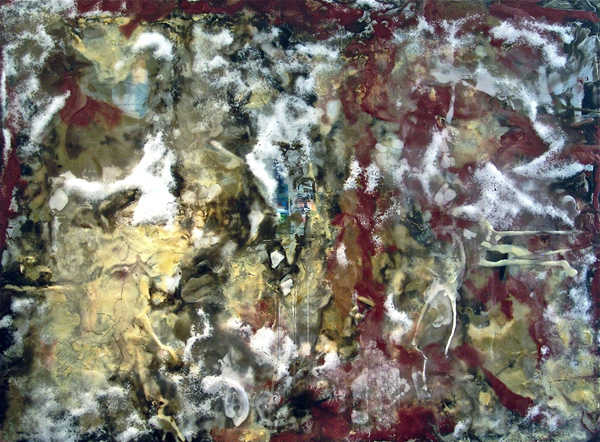
# 26
Pompeii: Epiphany
140" x 160" x 2" | Encaustic on wood
0
Status: Not For Sale
The love and passion for Pompeii of those who are aware of its significance has always been an important inspiration to my art. During the time I was studying about memory for my thesis, I came across some interesting connections between memory, history and the mind. One of the core points was the relationship between Freud’s writings and the ruins of Rome and Pompeii. Following his thoughts about psychotherapists as archeologists of the soul, I decided to study Pompeii in more depth. It fascinates me how Freud, during his journey to Italy, related the many layered ruins he saw in Pompeii to the dialectic of concealment and revelation pertaining to the therapeutic process and the psyche. This dialectic is the same that I encounter as I create my art, both with encaustic and oil. By using these two media to create many layers of heavy texture embedded in my work, I seek to highlight the quality of those materials that make the complex concept of the passage of time more visible. In this series, my artistic procedure was focused on processes of destruction-transformation-reconfiguration that would resonate with the Pompeian ruins. I worked with small pieces of wax left over from former works in this series, which I had destroyed and recombined in new configurations. Those fragments of wax became something that is both reminiscent of an old work and an element of a new one. Thus, in the process of painting, small pieces of wax play a role similar to what the ruins of Pompeii mean to us: fragments of information about what happened long ago. Therefore, they were transformed into traces of the memory of the former painting, reassembled in a particular arrangement that belonged to a past event (the former paintings). Thus, the artistic procedure resonates with the Pompeian ruins and become a metaphor for the concept of memory traces. To me, the possibility of creating a sense of time and defeating it is the most amazing quality of memory, transcending chronological limitations. What strikes me the most about Pompeii is the fact that the whole city is an instant frozen in time that brings us an untouched and unaltered scene from the past. It is like a sudden temporal suspension of a physical space that turns out to be eternal. It is a concrete snapshot of our past that speaks directly to our imagination. It is a real convergence between reality and fantasy, past and present. As a psychologist what captures my attention, first of all, is how human suffering transitions to historical awareness of our cultural roots. Second, the impressive way a historical event resonates with the psychical dynamics of contents that remain hidden and untouched due to repression (“The repression, which makes the psyche inaccessible and, at the same time, keeps it unaltered, can only be compared in the best way possible to a burial, as what happened to Pompeii, from which the city was reborn through shoveling”, (Freud, “Delusion and Dream in Wilhelm Jansen’s Gradiva”) That said, my Pompeii Series is about the interplay between oblivion and memory, impermanence and eternity, life and death. This group of works is the result of my free interpretation of what happened to people on that tragic day and how that tragedy relates to our psychological processes, becoming a precious key to help us understand who we are and what we do. My connection to Pompeii is even stronger since I am the grand daughter of Italian grand parents, both maternal and paternal. It is also my tribute to memory, and particularly, to the memory of those who died in the ashes of Mount Vesuvius

